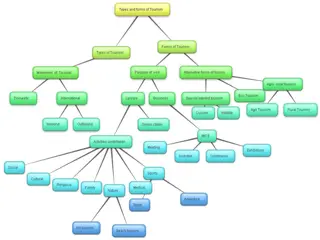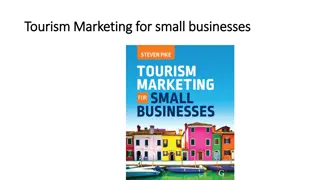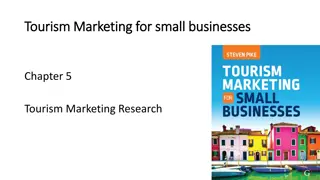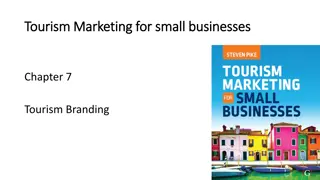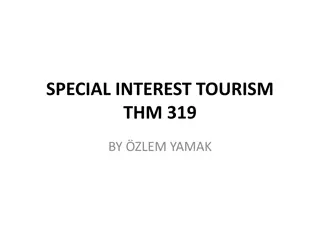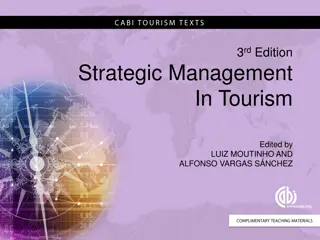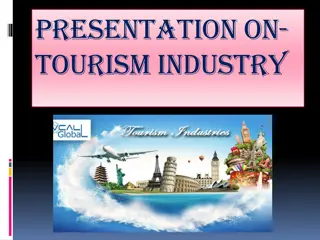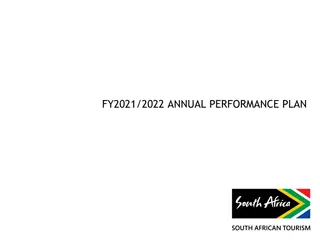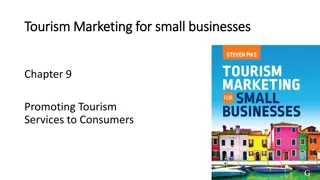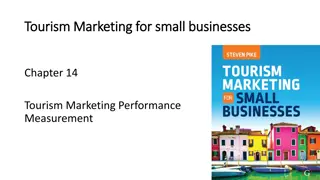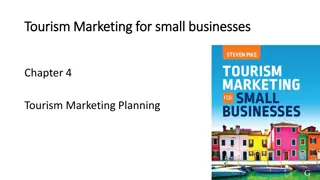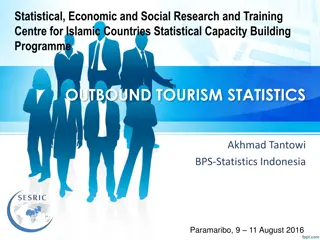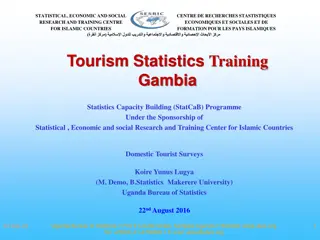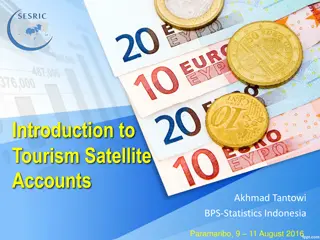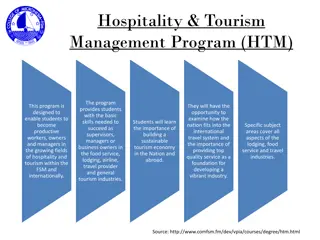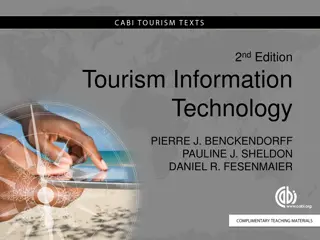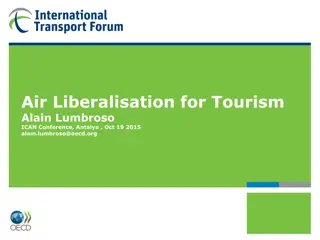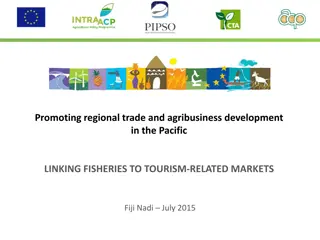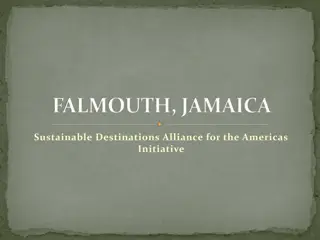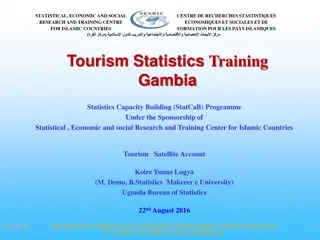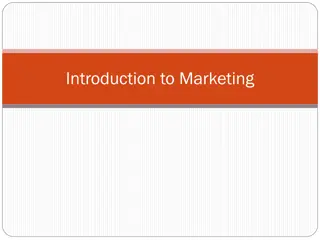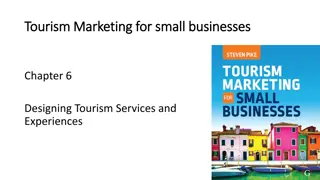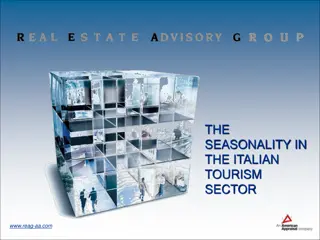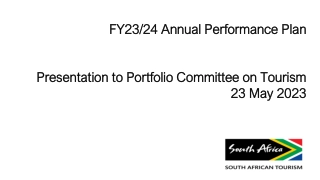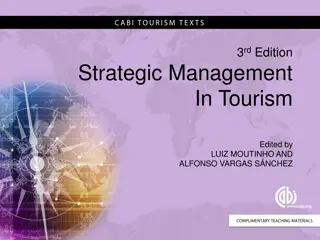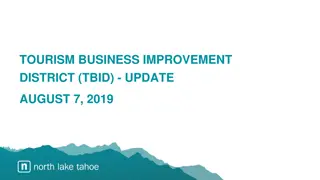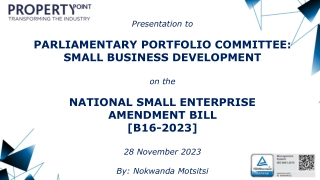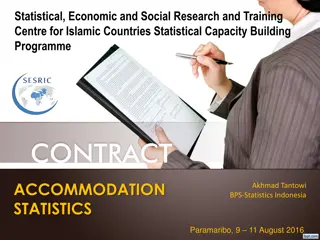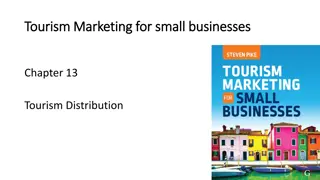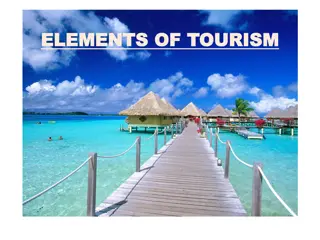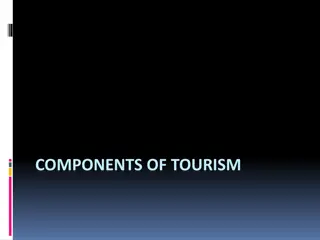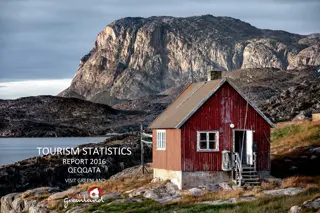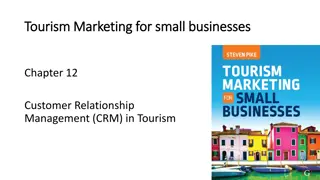Understanding Tourism Marketing for Small Businesses
Explore the key concepts of tourism marketing for small businesses, including the distinguishing characteristics of tourism services, the challenge of differentiation, and the importance of a marketing orientation. Discover how small tourism businesses can navigate marketing strategies different from large corporate brands, bridging theory with practical application to enhance their marketing efforts effectively.
- Tourism Marketing
- Small Businesses
- Distinguishing Characteristics
- Marketing Orientation
- Theory to Practice
Download Presentation

Please find below an Image/Link to download the presentation.
The content on the website is provided AS IS for your information and personal use only. It may not be sold, licensed, or shared on other websites without obtaining consent from the author. Download presentation by click this link. If you encounter any issues during the download, it is possible that the publisher has removed the file from their server.
E N D
Presentation Transcript
Tourism Marketing for small businesses Tourism Marketing for small businesses Chapter 1
Chapter learning aims Chapter learning aims To enhance your understanding of: the distinguishing characteristics of tourism services the challenge of differentiating tourism services the importance of a marketing orientation
Key terms Key terms Tourism Tourism is used as a generic descriptor, subsuming the many interrelated activities related to travel, holidays, hospitality, lodging, leisure, events, entertainment and recreation. Differentiation Standing out from competitors as being different, in the minds of consumers, on the basis of an attribute or benefit that is meaningful to them in the purchase situation. Marketing orientation An outward and forward thinking philosophy that dictates all marketing decision making is made with the interests of target consumers in mind.
Tourism Marketing for Small Businesses Tourism Marketing for Small Businesses 99% of the world s tourism businesses are small to medium sized enterprises Small businesses and not-for-profits (eg Museums) operate with scarce resources Small tourism businesses can t follow the same marketing strategies as the big corporate travel brands
A bridge between theory and practise A bridge between theory and practise The text focuses on how theory can be used in practical ways by small tourism businesses There is nothing so practical as a good theory A good theory provides a substantiated explanation of some aspect of our world. This explanation clearly and succinctly defines the key concepts involved, and the relationships between them, in a way that enables us to observe and measure, and make predictions about the outcome of future actions.
Distinguishing characteristics of tourism Distinguishing characteristics of tourism services services The majority of commercial activities in the tourism industry are in the form of services. It is important to recognise how the distinguishing characteristics of tourism services, relative to consumer products, have implications for the marketing planning process and the marketing mix.
Intangibility, risk and the critical role of Intangibility, risk and the critical role of consumer perceptions consumer perceptions The only physical evidence of a service we haven t previously experienced will be in the form of the information source So, the customer s expectations can only be realised after purchasing and travelling to the service The lack of physical evidence means the consumer can only base their purchase decision on the perceptions they hold in their mind about the alternative options
Intangibility, risk and the critical role of Intangibility, risk and the critical role of consumer perceptions consumer perceptions Another consequence for the consumer when purchasing an intangible service is perceived risk, and so an important part of tourism marketing is managing perceptions of risks: Financial risk Performance risk Physical risk Psychological risk Remember, tourism activities are often discretionary spending
Video link Video link https://www.youtube.com/watch?v=qsgFCvb9G28
Tourism Awards Tourism Awards reduce the risk of intangibility to consumers intangibility to consumers reduce the risk of
The role of people The role of people The tourism provider and the customer have traditionally been inseparable in the delivery of the tourism service Production and consumption occur more or less simultaneously People have been required to make tourism services happen, and this means jobs for the community While technological advances are leading to disruptions in the delivery of many tourism services, there will likely be limits to the extent that technology will replace human interaction, such as hotel robot concierges and driverless buses. In the short term people will continue to play a critical role in making most tourism services happen.
Activity 1.1 Activity 1.1 A restaurant with no humans? A restaurant with no humans? Would there be sufficient demand for a restaurant to provide this? How interested would you be with such an experience? What are the potential advantages and disadvantages for customers?
Variability of service quality Variability of service quality Perceptions of the quality of the service delivery can vary between customers The same service person can vary their performance over the course of a shift or a week Service delivery quality can also vary greatly between different staff Even if we have previously enjoyed a particular tourism service, there is no guarantee the experience will be exactly the same next time
Perishability and seasonality Perishability and seasonality A tourism service experience can t be stored for future use Any unused capacity at the end of the day is considered perished because the potential cash flow has been lost A major influence on perishability is seasonality. Seasonality represents fluctuations in demand over time, which can occur over the course of a day, a week, and between seasons during the year. An implication of perishability and seasonality is the need for yield management, where pricing is flexible to match fluctuating demand levels.
The social stage setting The social stage setting Many tourism services are performances acted out by suppliers and customers on a social stage Whereas intangible services in many other sectors, such as financial services for example, take place in a private setting, travellers frequently share the experience with other guests Issues that impact on appeal and satisfaction in this regard include: segregation of customer classes; congestion; experiences of the senses; making new friends; learning from others; and, the behaviour of other guests.
The challenge of differentiating tourism The challenge of differentiating tourism services services Tourism is fiercely competitive, for two key reasons. In most markets there are low barriers to entry for small business start-ups. In free markets, there are no rules dictating how many competing businesses are permitted to operate There is little if any legal protection from imitation of a good service idea. Really innovative tourism services emerge infrequently, and when they do they are quickly copied by competitors
Substitutability Substitutability It is difficult for small tourism businesses to gain a competitive edge in markets crowded with me too services, including larger corporates, offering similar features and benefits In many purchase situations one tourism service brand is substitutable for another in the mind of the consumer When brands are easily substitutable they are commodities that can only compete on price and volume
Cooperating to compete Cooperating to compete Small tourism businesses have much to gain from working cooperatively with other local businesses by sharing promotional resources and creating a bigger impact in the marketplace than they could individually Case 1.1 Austin s Arts et Metiers Hotel, Paris How could the hotel collaborate with nearby businesses, in a mutually beneficial way, to stimulate new customers?
Marketing orientation Marketing orientation The key challenge facing tourism businesses in the current competitive environment is to effectively cut through the clutter of competition and differentiate in the minds of consumers at the time a purchase choice is being considered. A marketing orientation is an outward and forward thinking philosophy of making decisions with the needs of the target consumer in mind.
Discussion questions Discussion questions Why does tourism represent discretionary spending for many consumers? Why do consumers perceptions play such an important role in tourism marketing? Why is differentiation in the market place so challenging for small tourism businesses?



